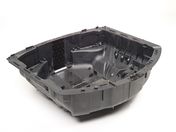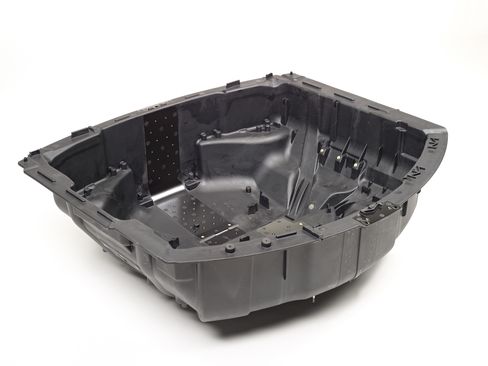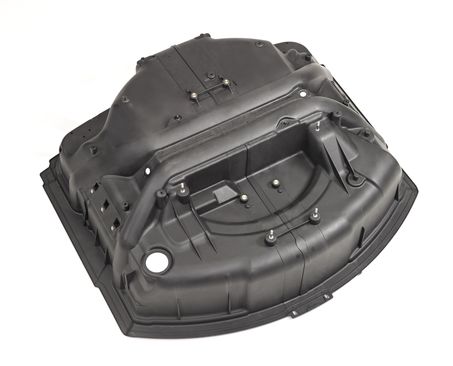Asia
EMEA

LANXESS Canada Contacts
Contact our Sites in Canada
Media Inquiries
General Inquiries
Please click here to e-mail LANXESS Canada with product inquiries and general requests.
Global Press Releases
2010-03-17
Highly filled polyamide 6 as an alternative to steel, aluminum and GMT
Injection-molded spare wheel recess with a bodywork-reinforcing effect
Single-stage production process with integrated GIT
Its outstanding stiffness and strength open the door to new applications in automotive engineering for highly reinforced polyamide 6 as an alternative to sheet steel, aluminum and glass-mat-reinforced thermoplastics (GMT). One current example is the spare wheel recess with integrated reinforcing channels in the new Audi A8. The recess is made of Durethan DP BKV 60 H2.0 EF, a highly filled polyamide 6 from LANXESS with 60 % glass fibers. “Our polyamide 6 is the material of choice because it enables precise injection molding of the part’s complex geometry. It would be very difficult to make the component from sheet metal due to the limited space available and the high draw ratios. Our plastic also enables direct integration of numerous functions. Incorporating these functions in a metal design would have required a large number of separate production and assembly steps with all the associated costs,” states Martin Klocke, Key Account Manager for Audi. One of the reasons for deciding against a GMT design was the huge amount of reworking the finely structured component would have required. The spare wheel recess is made by voestalpine Plastics Solutions, a company based in the Dutch town of Putte.
High component stiffness required
With dimensions of 100 x 85 x 32 cm, the spare wheel recess is unusually large for an injection-molded part. The plastic alone weighs approximately nine kilograms. The component is bonded and bolted to the body framework, and fulfils the additional function of reinforcing the rear end of the car. This is achieved by integrating two reinforcing channels, each around two meters long, using gas injection technology (GIT). The polyamide 6 makes a major contribution to the high overall stiffness. Its tensile modulus of approximately 19,000 MPa at ambient temperature (conditioned: 13,000 MPa) is twice that of a standard polyamide 6 filled with 30 % glass fibers. It also retains its stiffness at high temperatures – as required by Audi for components located close to the exhaust system, for example. This outstanding stiffness and strength are also important because the recess supports numerous fittings and attachments weighing a total of around 70 kg. These include the spare wheel, air spring compressor, vehicle jack, tools, battery and various control units. The battery is attached to an aluminum sheet that is integrated in the component. This stops it from becoming detached in the event of a rear-end collision.
Stable and reliable production with excellent recyclability
The spare wheel recess is made in a single-stage injection-molding process. Particular challenges include the size and 3D complexity of the molded part, the high shot weight of around 12 kg, precise back-injection of the aluminum sheet for the battery and integration of the GIT process for the reinforcing channels. Precise metering is achieved using a 2,700 metric ton injection molding machine with a screw that has a relatively large diameter of 150 mm.
First of all, the polyamide 6 is injected into the mold. The highly filled material’s excellent flowability – similar to that of a standard polyamide 6 with 30 % glass fibers – means that only two gates are required. The GIT process is then used to produce the reinforcing channels, the excess melt being forced into overflow cavities. “Our material makes thin walls possible. What’s more, the expelled melt can be returned to the process as a recyclate at a ratio of 30 %,” explains Markus Hildebrandt, a GIT expert at LANXESS. Another key benefit of the polyamide 6 is the fact that its impressive flowability results in mold wear comparable to that observed when using a standard polyamide 6 with 30 % glass fibers.
Customer service for optimum component quality
LANXESS provided a comprehensive range of services during the development of the spare wheel recess. This included using mold flow analyses to optimize wall thicknesses and minimize distortion. LANXESS also helped with mold construction, mold proving and initial production trials. In addition, it tested the GIT material’s recyclability and used integrative simulation to calculate the molded part’s vibration characteristics.
Forward-Looking Statements
This news release contains forward-looking statements based on current assumptions and forecasts made by LANXESS AG management. Various known and unknown risks, uncertainties and other factors could lead to material differences between the actual future results, financial situation, development or performance of the company and the estimates given here. The company assumes no liability whatsoever to update these forward-looking statements or to conform them to future events or developments.
Information for editors:
All LANXESS news releases and their accompanying photos can be found at http://corporate.lanxess.de/en/media/press-releases/. Recent photos of the Board of Management and other LANXESS image material are available at http://fotos.lanxess.de/index_en.html. The latest TV footage, audiofiles and podcasts can be found at http://corporate.lanxess.com/en/media/audio-video/.
You can find further information concerning LANXESS chemistry in our WebMagazine at http://webmagazine.lanxess.com.
LANXESS is a leading specialty chemicals company with sales of EUR 5.06 billion in 2009 and currently around 14,300 employees in 23 countries. The company is represented at 43 production sites worldwide. The core business of LANXESS is the development, manufacturing and marketing of plastics, rubber, intermediates and specialty chemicals.
- Gallery






